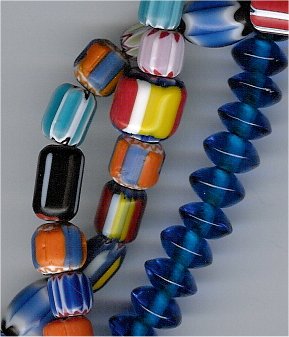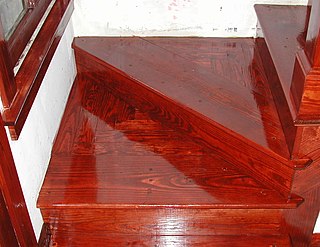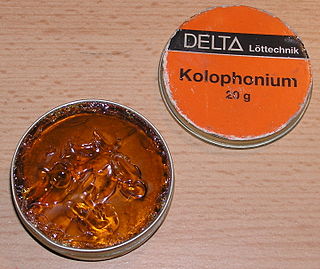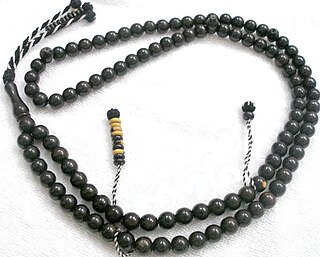Faturan, in Middle Eastern beadwork, is a material used to make beads, notably in the making of komboloi and misbaha.
Contents
- History
- In the bead trade
- Faturan oxidization
- Faturan types
- Gold Faturan
- Golden Lava Flow Faturan
- Notes

Faturan, in Middle Eastern beadwork, is a material used to make beads, notably in the making of komboloi and misbaha.

"Bakelite" and "Parkesine" are both synthetic resins named after their inventors. And so "Faturan", named after its original inventor, became a brand of cast thermosetting phenol formaldehyde resin, similar to Bakelite and Catalin, manufactured by Traun & Son of Hamburg., [1] [2] developed in the early 20th century, and produced until the 1940s.[ citation needed ]

In the bead trade, "Faturan" is thought to be a mixture of natural amber shavings with other materials, and is described as having been invented in the Middle East in the 18th or 19th century, however, there is some dispute over this within the trade.
The Komboloi Museum, Nafplio, Greece, insists that a Kuwaiti chemist called Esmaeel Almail Faturan first made beads from amber fillings mixed with other natural resins, rather than synthetic, long before the well known synthetic resins were mass-produced. The National Historical Museum, Athens, has on display komboloi made of Faturan dating to 1821.
"Faturan" became the protected brand name of one particular German company who mass-produced synthetic resin in rod form for making beads. These beads are now rare, but rarer still are the handmade beads of Arava Faturan's time.
The first Bakelite that arrived in Turkey and the Middle East in the early 1900s was mainly in the form of drawer and furniture knobs and handles. This coincided with when the first prayer bead strands made of Bakelite began to appear on the market.
The bead carvers, mainly in Turkey, were swift to understand that Bakelite was a material that could be well carved, had a great appearance, and could replace amber. Each master also had his secret "recipe", even heating in various liquids and oils, and making it undergo various physical or chemical processes to obtain the most beautiful product.
The original and genuine Faturan beads were mainly in shades of red or yellow. The last genuine Faturan beads were made in the 1940s, and production ended mainly due to the Second World War, when the supply of raw material became very scarce. The demand for genuine Faturan, often confused for amber, has always been great among prayer bead, tasbih and komboloi collectors. Genuine pre-war Faturan, with beads still intact, in complete strands, and made from one single type of material, are considered museum items and fetch extremely high prices by both institutional and individual auction bidders.

Faturan, as a material, displays an extreme example of a characteristic common to most phenolics - surface oxidization. Most phenolic will, over time, oxidize to a darker form of its original color. However, Faturan has the unique characteristic of always oxidizing to a dark red, regardless of the original color. This red color caused the material to become known as ‘cherry amber’ in the Middle East. If the red surface oxidization is removed, the original color of the material is exposed underneath.[ citation needed ]

The most widely known types of Faturan is called damar. The swirls show the combination of more than one type of Faturan being mixed and combined, for example, transparent mixed with a dark color. Most Ottoman Faturan prayer beads were made from Faturan rods that have a swirl effect. This is called "eye damar”.[ citation needed ]
The properties found inside Faturan determine its desirability and value, the most valuable being gold, in the forms of gold leaf, dust or metal, added when molten. Gold Faturan was used for making jewelry beads, rings, and accessories. Tribal beads were used as dowry gifts and for making necklaces and other jewelry in North Africa and Asia.[ citation needed ]
One of the rarest and sought after Faturan types is called Golden Lava Flow Faturan. It is a very rare mixture that involves a complicated and costly method of preparing a combination of melted gold and infusing it with Faturan. As the gold is in a molten form when combined with Faturan, it gives the material a molten lava look.[ citation needed ]

Amber is fossilized tree resin that has been appreciated for its color and natural beauty since Neolithic times. Much valued from antiquity to the present as a gemstone, amber is made into a variety of decorative objects. Amber is used in jewelry and has been used as a healing agent in folk medicine.

A bead is a small, decorative object that is formed in a variety of shapes and sizes of a material such as stone, bone, shell, glass, plastic, wood, or pearl and with a small hole for threading or stringing. Beads range in size from under 1 millimeter (0.039 in) to over 1 centimeter (0.39 in) in diameter.

Bakelite, formally polyoxybenzylmethyleneglycolanhydride, is a thermosetting phenol formaldehyde resin, formed from a condensation reaction of phenol with formaldehyde. The first plastic made from synthetic components, it was developed by Leo Baekeland in Yonkers, New York, in 1907, and patented on December 7, 1909.

In polymer chemistry and materials science, a resin is a solid or highly viscous substance of plant or synthetic origin that is typically convertible into polymers. Resins are usually mixtures of organic compounds. This article focuses mainly on naturally occurring resins.

Petrochemicals are the chemical products obtained from petroleum by refining. Some chemical compounds made from petroleum are also obtained from other fossil fuels, such as coal or natural gas, or renewable sources such as maize, palm fruit or sugar cane.

Varnish is a clear transparent hard protective coating or film. It is not to be confused with wood stain. It usually has a yellowish shade due to the manufacturing process and materials used, but it may also be pigmented as desired. It is sold commercially in various shades.
Catalin is a brand name for a thermosetting polymer developed and trademarked in 1927 by the American Catalin Corporation of New York City, when the patent on Bakelite expired that year. A phenol formaldehyde resin, it can be worked with files, grinders, and cutters, and polished to a fine sheen.

Leo Hendrik Baekeland was a Belgian chemist. Educated in Belgium and Germany, he spent most of his career in the United States. He is best known for the inventions of Velox photographic paper in 1893, and Bakelite in 1907. He has been called "The Father of the Plastics Industry" for his invention of Bakelite, an inexpensive, non-flammable and versatile plastic, which marked the beginning of the modern plastics industry.

In materials science, a thermosetting polymer, often called a thermoset, is a polymer that is obtained by irreversibly hardening ("curing") a soft solid or viscous liquid prepolymer (resin). Curing is induced by heat or suitable radiation and may be promoted by high pressure or mixing with a catalyst. Heat is not necessarily applied externally, and is often generated by the reaction of the resin with a curing agent. Curing results in chemical reactions that create extensive cross-linking between polymer chains to produce an infusible and insoluble polymer network.

Phenol formaldehyde resins (PF) are synthetic polymers obtained by the reaction of phenol or substituted phenol with formaldehyde. Used as the basis for Bakelite, PFs were the first commercial synthetic resins. They have been widely used for the production of molded products including billiard balls, laboratory countertops, and as coatings and adhesives. They were at one time the primary material used for the production of circuit boards but have been largely replaced with epoxy resins and fiberglass cloth, as with fire-resistant FR-4 circuit board materials.

In metallurgy, a flux is a chemical cleaning agent, flowing agent, or purifying agent. Fluxes may have more than one function at a time. They are used in both extractive metallurgy and metal joining.

A Misbaha, subḥa, tusbaḥ (Somali), tasbīḥ, or tespih is prayer beads often used by Muslims for the tasbih, the recitation of prayers, the dhikr, as well as to glorify Allah. It is similar to the Japamala used in Hinduism, Jainism, Sikhism, and Buddhism, and the Rosary in Catholicism.

Dammar, also called dammar gum, or damar gum, is a resin obtained from the tree family Dipterocarpaceae in India and Southeast Asia, principally those of the genera Shorea or Hopea. The resin of some species of Canarium may also called dammar. Most is produced by tapping trees; however, some is collected in fossilised form on the ground. The gum varies in colour from clear to pale yellow, while the fossilised form is grey-brown. Dammar gum is a triterpenoid resin, containing many triterpenes and their oxidation products. Many of them are low molecular weight compounds, which easily oxidizes and photoxidizes.

Worry beads or komboloi/kompoloi is a string of beads manipulated with one or two hands and used to pass time in Greek and Cypriot culture. Unlike the similar prayer beads used in many religious traditions, worry beads have no religious or ceremonial purpose.

A dzi bead a type of agate bead of uncertain origin found in the Himalayan regions including Tibet, Bhutan, and Ladakh.

Prayer beads are a form of beadwork used to count the repetitions of prayers, chants, or mantras by members of various religions such as Hinduism, Buddhism, Shinto, Umbanda, Islam, Sikhism, the Baháʼí Faith, and some Christian denominations, such as the Roman Catholic Church, the Lutheran Church, the Oriental Orthodox Churches, and the Eastern Orthodox Churches. Common forms of beaded devotion include the mequteria in Oriental Orthodox Christianity, the chotki or komposkini or prayer rope in Eastern Orthodox Christianity, the Wreath of Christ in Lutheran Christianity, the Dominican rosary of the Blessed Virgin Mary in Roman Catholic Christianity, the dhikr in Islam, the japamala in Buddhism and Hinduism, and the Jaap Sahib in Sikhism.
Wood glue is an adhesive used to tightly bond pieces of wood together. Many substances have been used as glues. Traditionally animal proteins like casein from milk or collagen from animal hides and bones were boiled down to make early glues. They worked by solidifying as they dried. Later, glues were made from plant starches like flour or potato starch. When combined with water and heated, the starch gelatinizes and forms a sticky paste as it dries. Plant-based glues were common for books and paper products, though they can break down more easily over time compared to animal-based glues. Examples of modern wood glues include polyvinyl acetate (PVA) and epoxy resins. Some resins used in producing composite wood products may contain formaldehyde. As of 2021, “the wood panel industry uses almost 95% of synthetic petroleum-derived thermosetting adhesives, mainly based on urea, phenol, and melamine, among others”.

Murano beads are intricate glass beads influenced by Venetian glass artists. Since 1291, Murano glassmakers have refined technologies for producing beads and glasswork such as crystalline glass, enamelled glass (smalto), glass with threads of gold (aventurine), multicolored glass (millefiori), milk glass (lattimo) and imitation gemstones made of glass.

Thermoplastic road marking paint, also called hot melt marking paint, is a kind of powder paint. When applied as road surface markings, a hot melt kettle is used to heat it to 200 °C (392 °F) to melt the powder, after which it is sprayed on the road surface. After cooling, the paint forms a thick polymer layer, which is wear-resistant, bright, and reflective. In recent years, practical applications tests have proved that the marking lines lack surface roughness and can easily cause wheel slip, resulting in a traffic accident in snow and rainy weather. Therefore, some countries once restricted the use of this paint or demand the use of anti-skid particles. In order to increase the antiskid performance of the line, thermoplastic paint has added reflective glass beads and other coarse fillers. Thermoplastic can be used very effectively for large anti-skid areas on roads and pedestrian walkways by adding glass beads. It can be produced in any colour and is suitable for car parks, factory walkways, and many other areas. It hardens quickly and can be driven over after just a few minutes.